The alleyways of Euljiro are lined with family-owned restaurants and pubs that have served hearty meals and refreshing drinks for generations. The traditional haunts of Euljiro’s workforce now also attract young locals, tourists, and art enthusiasts who enjoy the food as much as Euljiro’s colorful history.
After sunset, Nogari Alley in Euljiro 3-ga is packed with people winding down the day with draft beer and nogari (dried young pollock). In 2015, the Seoul Metropolitan Government designated the alley as Seoul Future Heritage for its cultural value.
ⓒ Lee Yusin
Euljiro in downtown Seoul is home to many nopo, best described in English as long-standing family businesses. These old bars and restaurants share narrow alleyways with print, metal, and wood workshops. Euljiro began to flourish in the late 1960s with the construction of Sewoon Plaza, the first commercial-residential complex in Korea. During the 1970s, the area was the epicenter of Korea’s postwar economic boom, but it began to decline in the wake of rapid changes in the country’s industrial structure. Workshops where craftsmen burned the midnight oil closed down one by one and customers at local businesses began to thin.
Euljiro eventually rebounded in the late 2010s when fledgling artists gravitated here and took over vacant spaces that were uncharacteristically cheap considering their prime location. New art studios and workshops reenergized the area and attracted a new generation of visitors. Soon, the Euljiro nopo became hotspots among young art aficionados, proving that their great food and retro vibe had never really lost their allure.
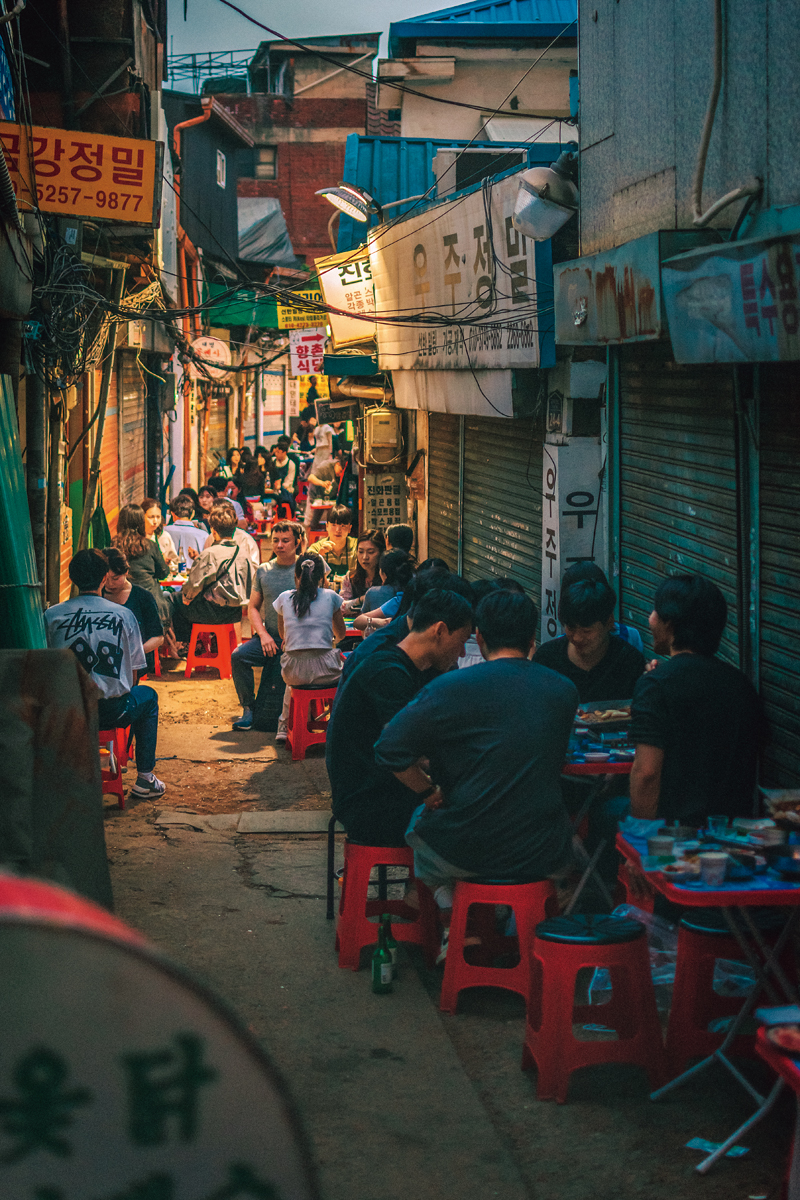
An alley next to Daelim Plaza, famous for grilled pork belly. In recent years, it has become a popular destination among young people. Long lines often form in front of Euljiro’s eateries, most of which have been in business for over 20 years.
ⓒ Seoul Tourism Organization
NORTHERN NOODLES
Pyongyang naengmyeon, as the name suggests, is a local specialty of the North Korean capital. When people from Pyongyang opened naengmyeon restaurants in Seoul in the1930s, it caught on as a summer delicacy and gradually gained widespread popularity. The simple, unpretentious dish consists of buckwheat noodles served in a meat broth that is simmered for a long time before being chilled. Swirled into a small pile and placed in a deep bowl, the noodles are often garnished with pear slices and half of a hardboiled egg.
Woo Lae Oak, located a one-minute walk from Euljiro 4-ga subway station, is a favorite among foodies seeking this northern noodle dish. Hailing from Pyongyang, Jang Won-il and his wife Na Jeong-il started the restaurant in 1946. Since Jang’s passing in 1972, his descendants have continued his legacy. The restaurant’s original name was Seobukgwan, with seobuk referring to the Pyongan, Hamgyong, and Hwanghae Provinces in the northern end of the Korean peninsula.The Korean War erupted four years after the restaurant’s opening, forcing Jang and Na to flee, but they later returned and reopened under the current name, which means “at home again.”
Woo Lae Oak’s business thrived and its record for sales of Pyongyang naengmyeon in a single day is 2,000 bowls. Today, customers include both locals and out-of-towners, many of whom stop by after having toured nearby Changgyeong Palace. Another of the restaurant’s specialties is bulgogi. Thin slices of meat, usually beef, are cooked on a table-top grill with concave edges and a raised center. A sweet marinade enriches the flavor of the dish, making it a favorite among foreign guests.
Eulji Myeonok was another famous Pyongyang naengmyeon restaurant in Euljiro. Opened in 1985, it operated at the same location for decades, and for a while, it seemed as if it might survive the area’s urban redevelopment. A group of long-established property owners had sued Jung District to have its approval of the project reversed, and the city responded by announcing plans to try and preserve Euljiro’s living heritage. Ultimately, it was to no avail, and so, before opening time on June 25, 2022, more than 100 people lined up in front of Eulji Myeonok for a final, memorable bowl of cold noodles.
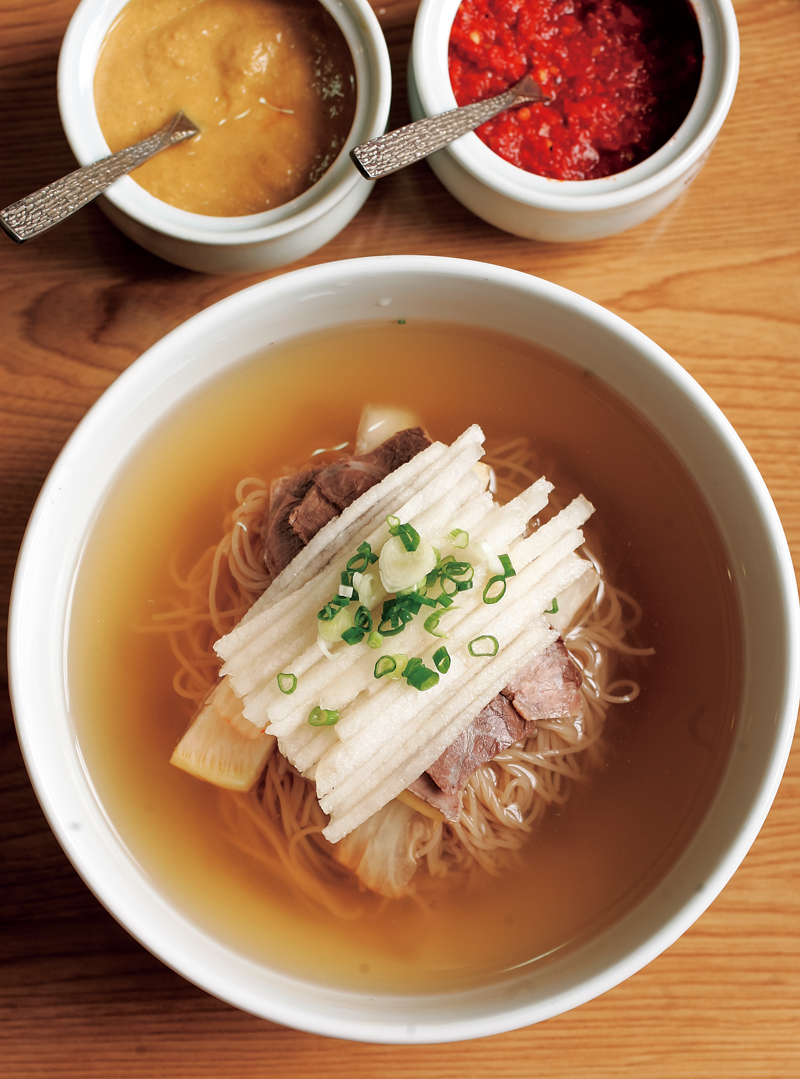
Woo Lae Oak’s Pyongyang naengmyeon. The broth for this dish is usually made from beef, but occasionally, dongchimi (radish water kimchi) juice is mixed in for a more refreshing flavor. The cold noodle dish is garnished with pear slices and radish pickled in salt, vinegar, and sugar.
ⓒ Park Mee-hyang
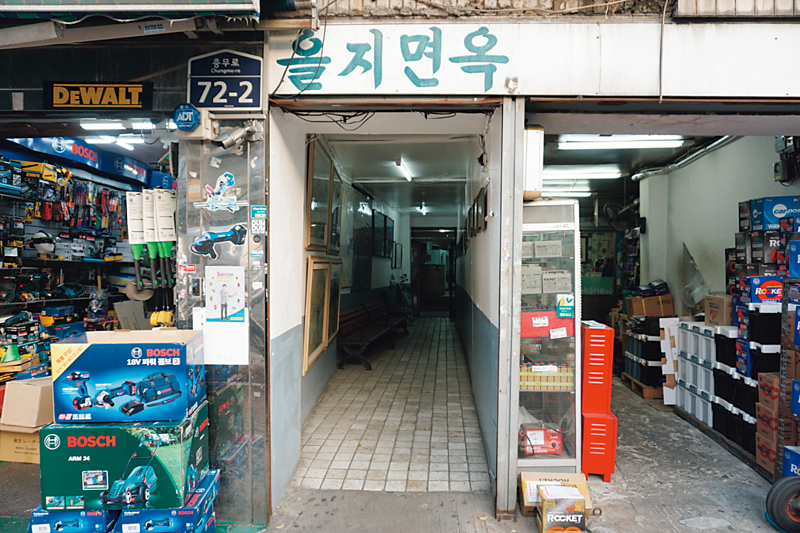
Opened in 1985, the renowned Eulji Myeonok was famous for its Pyongyang naengmyeon. Its quaint charm was beloved by old regulars and new customers alike. After losing along legal battle, it was forced to shut down in 2022.
ⓒ Shinhan Card, URBANPLAY
BIRTH OF NOGARI ALLEY
In 2018, the Ministry of SMEs and Startups addressed the challenges faced by local entrepreneurs by launching the Hundred-Year Store Development Plan. The ive was to select and support businesses with historical value and growth potential that had been in operation for more than 30years.
Opened in 1980, Eulji OB Bear, known for its draft beer, appeared on the Hundred-Year Store list in the project’s first year. Since freshness is key to exceptional draft beer, first-generation owner Kang Hyo-keun stored his kegs in a refrigerator set at 4 °C in winter and 2 °C in summer. The establishment was famous not only for its beer but also grilled nogari. The dried young pollock was placed over red-hot coal briquettes until golden brown and served with homemade red pepper paste. It paired perfectly with the affordably priced beer that allowed even those on a tight budget to buy more than one round.
When Eulji OB Bear opened its doors, word spread quickly. The 19.8-square-meter pub was soon packed to capacity on a regular basis. Over time, nearby competitors also serving nogari as a bar snack popped up one after another, earning the street nationwide fame and the nickname Nogari Alley. This culminated in an annual beer festival, held each May in pre-pandemic times, that filled the street with an air of excitement. The Seoul Metropolitan Government selected the alleyway as Seoul Future Heritage in 2015 and recognized Eulji OB Bear as the originator of Nogari Alley.
Nopo commonly face conflict with property owners and eviction due to urban redevelopment, and Eulji OB Bear was no exception. Kang’s daughter Kang Ho-shin and her husband Choi Su-young, who had taken over the management in the early 2010s, eventually lost a years-long legal battle against the building’s new owner, and the cherished pub was forcibly demolished in April 2022. Neither its heritage designation nor protests by regulars and civic groups shielded it from the landlord’s business ambitions. Although the couple reopened near Gyeongui Line Book Street in Seoul’s Mapo District in March 2023, they never gave up hope of returning to Euljiro. And so it came that on February 16, 2024, the legendary establishment made its triumphant comeback, reopening just 50 meters from Exits 9 and 10 of Euljiro 3-ga subway station.
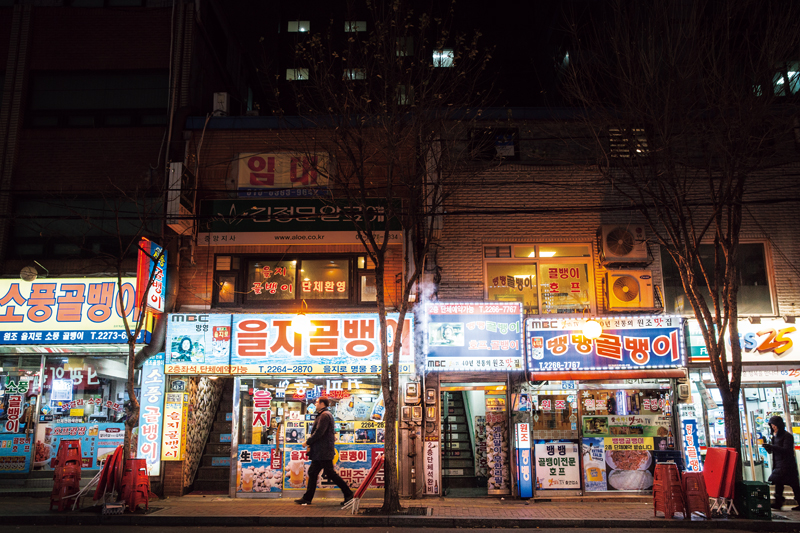
The beginnings of Golbaengi Alley, south of Euljiro 3-g Station, date back to the 1970s when golbaengi muchim (spicy sea snail salad) became a regular accompaniment to draft beer. Most of the restaurants here have been in business for over 30 years.
ⓒ Shinhan Card, URBANPLAY
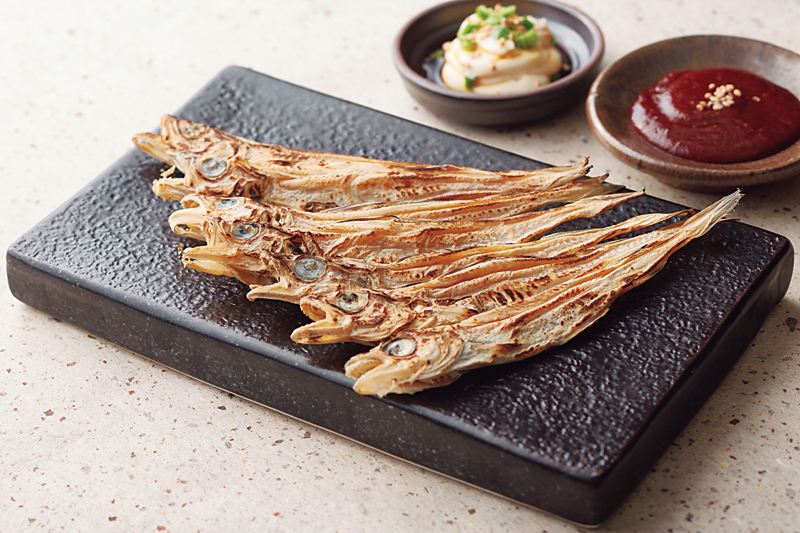
When Eulji OB Bear opened in 1980, owner Kang Hyo-keun grilled dried young pollock and served it with draft beer. This new combination became a hit, and the alley was dubbed Nogari Alley after other bars serving the popular snack opened nearby.
ⓒ Korea Tourism Organization
COMMITMENT TO TASTE
Other famous Euljiro nopo are Chosunok, Munhwaok, and Yangmiok. Chosunok, which opened in 1937, is the place to go for a true taste of beef galbi, or Korean short ribs. The secret to their extraordinary flavor is soaking them for a day in a marinade containing dark soy sauce, sesame oil, garlic, and sugar, and then grilling them over coal briquettes. The founder’s son, Kim Jeong-hak, is well-known as the publisher of Monthly Baduk, a magazine about the popular board game.
Munhwaok, near Euljiro 4-ga Station, opened in 1952. The restaurant offers seolleongtang, or ox bone soup, a dish loved by many for its rich broth made from beef leg bones and brisket. Yangmiok is a decades-old establishment in Euljiro 3-ga, which opened in 1992. Specializing in grilled beef tripe, it gained fame when late President Kim Dae-jung became a frequent diner here. Unfortunately, a fire destroyed the original restaurant in 2021, but its culinary legacy lives on in the Namdaemun area, home to Korea’s largest traditional market.
Despite the challenges faced by nopo over the years, their owners’ dedication remains steadfast and their offerings continue to entice patrons’ taste buds.